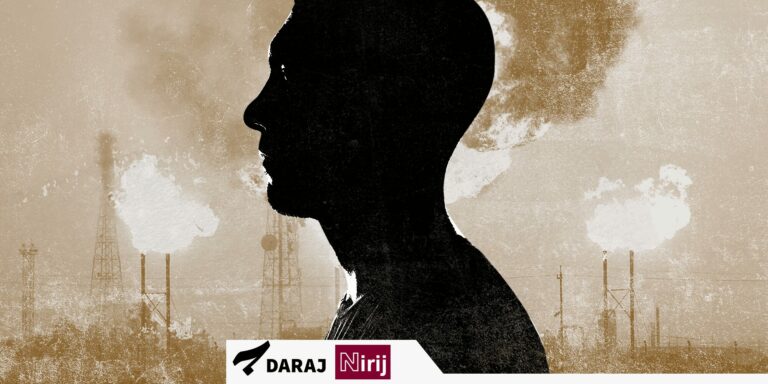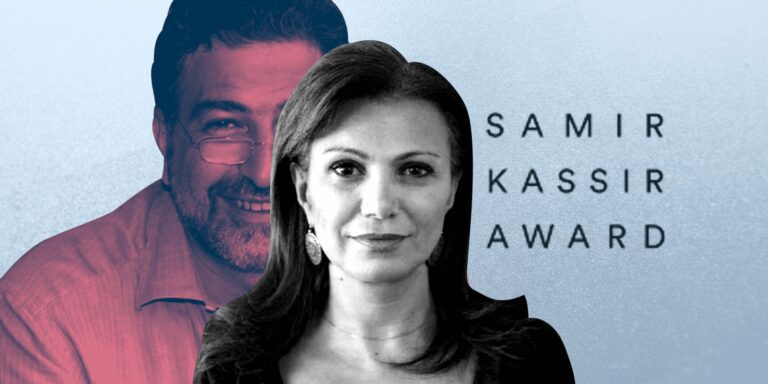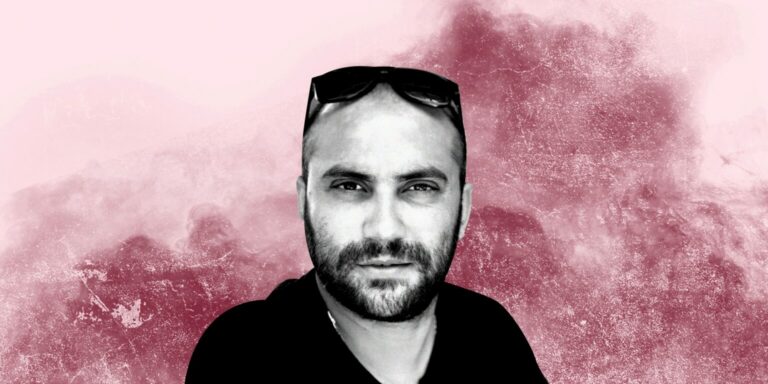This investigation was completed as part of a collaboration between Tiny Hand and Daraj
In a space not exceeding three square meters and on rough sand, Rama Al-Thabet, a teacher, laid down a foam mattress for 13 students to sit on. They gather daily at five in the afternoon when the lesson begins.
Rama, an eleventh-grade student, was displaced with her family from their home in Gaza to one of the camps in Deir al-Balah. She stopped studying and learning entirely, just as everything else did because of the war.
After months of displacement, Rama decided to transform the space between the tents into a makeshift classroom. She bought pens with her own allowance and taped pieces of nylon together, creating something resembling a school board to write on. Above it, she placed the word “Gaza,” the dream unanimously shared by the students. They all repeated “Returning to Gaza and for the war to stop” when asked what they dream of. Rama, the “teacher” of the makeshift class, also shares this dream.
Rama shares a warm relationship with the children, evident in their faces and enthusiasm as they head to her class. They arrive early and wait for her, as this hour-long lesson offers them a brief escape from the war and destruction surrounding them.
The class hour is not free from the noise of war. Rama describes how sometimes during the lesson, explosions can be heard near the camp, causing the students to panic in fear.
“When a loud explosion happens, I hug them all so they don’t run out of the tent in terror. We hold each other to ease the tension, and then I continue the lesson, overcoming the situation,” Rama explains.
Although Rama is only seventeen years old, she appears to be an experienced teacher. She incorporates competitions and different methods into her lessons to encourage student interaction. She doesn’t just teach them; she also provides small rewards and prizes.
Rama pays special attention to students struggling with pronouncing English letters, considering it a challenge she must overcome. Her joy is indescribable when she witnesses improvement in their speech and pronunciation.
Suddenly, applause erupted from within the class, accompanied by the sound of Israeli drones, or “zannana” as the Gazans call them, which fly overhead all day. This is how Rama chose to distract the children from the drone noise that barely leaves them be for a minute.
Rama has not received support from anyone and will continue to teach the children even with the simplest methods. She tells us, “My wish is to continue my education, to keep helping children with their education and achieving their dreams, and to uplift education here in Palestine.”
Seven months of war have devastated education in Gaza, with over 80 percent of Gaza’s schools suffering significant damage or being destroyed due to the fighting, according to the United Nations.
This destruction has burdened Gazans, including Marwan Thabet, a father of four children. Despite losing his home, his job, and being displaced to Deir al-Balah camp, he cannot bear to see his children deprived of education, especially since Palestinians, as he says, “are among the most educated people in the world.”
His youngest daughter, Dana, is one of the students in Rama’s modest class. Marwan sees this class as an opportunity for his daughter to continue her education. He says, “My daughter was one of the first students to come to this tent. It’s the norm for a child to be a student first, not a displaced or homeless person.”
Marwan believes that children in Gaza have lost everything today, including their education and the routine they once had. Their natural state is to be students in their schools. “This is their life and their natural situation, and they have the right to live it.”
A statement issued last month by a group of 25 United Nations experts pointed out the “reasonable question of whether there are deliberate efforts to comprehensively destroy the Palestinian education system, an act known as ‘scholasticide.'”
This is indeed what Marwan fears. And yet, he is hoping to return to his home, life, and work as an electronic marketing manager — in short, “a return to a normal human state,” as he puts it.
His daughter Dana also dreams of returning to her school, meeting her teachers, friends, and books again. She tells us:”My dream is for this war to end.”
Before the war, there were 813 schools in Gaza employing around 22,000 teachers, according to the Global Education Cluster, a research group working with the United Nations. Many of these schools were run by the United Nations Relief and Works Agency for Palestinian Refugees (UNRWA).
After the war, more than 85 percent of these schools were damaged or destroyed, according to a study by the Education Cluster based on satellite images. The study indicated that more than two-thirds of Gaza’s schools would either need to be rebuilt from scratch or require extensive repairs before their buildings could be safely used again.
Additionally, more than 320 schools have been used as shelters for the displaced from Gaza, with over half of them suffering direct hits or significant damage from nearby explosions.
The United Nations has documented at least 5,479 students, 261 teachers, and 95 university professors killed in Gaza since October, in addition to at least 7,819 students and 756 teachers injured.
Escaping from Reality to Virtual Reality
Everyone here is trying to survive, each according to their abilities and the bitterness of their experiences. The problems facing children are not limited to their interrupted education; the traumas they have endured are among the biggest challenges for them and their families.
Take Musab Ali, for example, an electronics and industrial control specialist. From within his tent, he strives to help children overcome the psychological difficulties they have faced.
Musab’s son, Amin, suffered an injury that affected him psychologically. Therefore, Musab used virtual reality goggles as a treatment for his child, helping him cope with what he had been through. Musab tells us that this experiment was successful with his son, which motivated him to share it with others as well.
The project involves a virtual reality experience using special goggles, allowing children to play in a virtual environment made up of forests and animals designed by Musab and his team.
Musab, who used to own a virtual reality game development company, has the appropriate tools to implement this project, which is based in a tent near the Al-Aqsa Martyrs Hospital in Deir al-Balah.
After months of war and the difficult situations they have endured, children today need significant psychological support. Musab noticed this starting with his own child, who was injured during the war.
“Children need to be in a new environment away from war and destruction, and to disconnect for some time from their daily lives,” he tells us.
Based on his experience, Musab found that the children responded positively, transitioning from a state of severe psychological distress and complete isolation to gradual improvement, especially since some children had difficulties communicating with their parents as well.
Musab and his team began creating an environment filled with trees and animals, allowing children to enter a new setting far removed from war and destruction, completely separating them from their daily lives in Gaza.
Musab says: “After my experiments and work with them, I found that their condition changed, and I see signs of joy on their faces again.” The first thing the children would say was, “Uncle Musab, I don’t want to leave this place; let me stay here because outside there is continuous war.”
Among the programs Musab designed are those for psychological comfort and awareness about the dangers of remnants of war and bombs left behind by the Israeli army after they leave the area.
Despite the challenges he faces in this work, such as frequent power outages and weak internet connectivity, his motivation to help children affected by war trauma keeps him going.
Musab explains that the idea of raising awareness about the dangers of remnants of war comes from painful experiences. Children play with war remnants, leading to severe injuries. Through the program, children learn about the effects of weapons and understand the dangers they pose. The goal is for the environment to realistically simulate real life so children can tangibly understand the risks and learn how to avoid them.
Musab describes how, through the program, children enter a realistic environment, such as a destroyed house with bombs and missiles. A child’s first reaction upon seeing them is usually to pick them up. When they do, it “explodes” and emits a real flash. This is what Musab aimed to achieve by designing an environment that closely resembles this scenario, so the child understands the danger of what might be found among the debris.
Musab concludes by telling us, “My message as a young Palestinian in the midst of conflict is: We are a people who love life, and we have the ability to influence and innovate in the world.”





